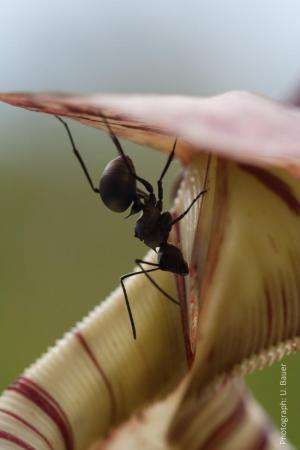Pitcher plants 'switch off' traps to capture more ants

Insect-eating pitcher plants temporarily 'switch off' their traps in order to lure more prey into danger, new research from the University of Bristol, UK, and the University of Cambridge, UK, has found.
Dr Ulrike Bauer from Bristol's School of Biological Sciences and colleagues studied tropical pitcher plants that use slippery pitfall traps to capture insects.
Dr Bauer said: "The plant's key trapping surface is extremely slippery when wet but not when dry. For up to eight hours during dry days, these traps are 'switched off' and do not capture any of their insect visitors. At first sight, this is puzzling because natural selection should favour traps that catch as many insects as possible."
Surveys of wild plants in Borneo revealed that the traps sporadically captured large 'batches' of ants from the same species. The researchers then conducted experiments in which they artificially kept the trapping surfaces wet all the time. They found that wetted plants no longer captured large 'batches' of ants.
"Ants are social insects," Dr Bauer explained. "Individual 'scout' ants search the surroundings of the nest for profitable food sources. When they find a pitcher trap full of sweet nectar, they go back to the colony and recruit many more ant workers. However, a trap that is super-slippery all the time will capture most of these scout ants and cut off its own prey supply."
The researchers found that ant recruitment was impeded when the traps were continually kept wet.
Dr Bauer said: "By 'switching off' their traps for part of the day, pitcher plants ensure that scout ants can return safely to the colony and recruit nest-mates to the trap. Later, when the pitcher becomes wet, these followers get caught in one sweep. What looks like a disadvantage at first sight, turns out to be a clever strategy to exploit the recruitment behaviour of social insects."
More information: 'How to catch more prey with less effective traps: explaining the evolution of temporarily inactive traps in carnivorous pitcher plants' by Ulrike Bauer, Walter Federle, Hannes Seidel, T. Ulmar Grafe and and Christos C. Ioannou in Proceedings of the Royal Society B (2015). rspb.royalsocietypublishing.or … .1098/rspb.2014.2675
Journal information: Proceedings of the Royal Society B
Provided by University of Bristol



















